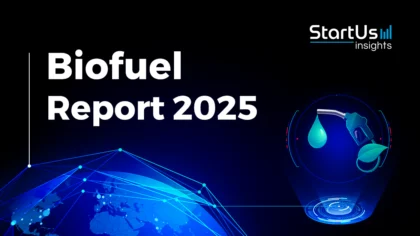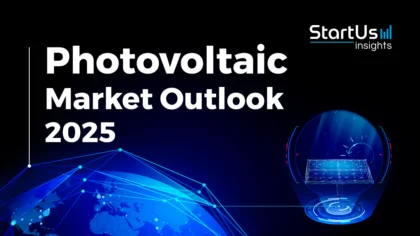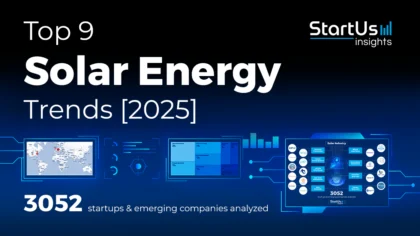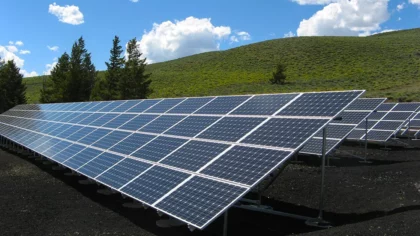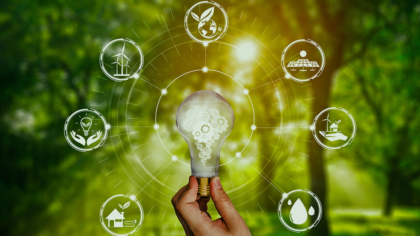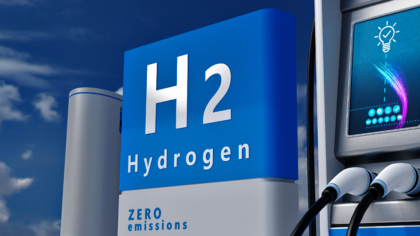Advances in energy technology focus on decarbonization, decentralization, and digitization. For example, solar cells and green hydrogen production reduce carbon footprints while ensuring energy reliability. At the same time, blockchain enables peer-to-peer (P2P) energy trading. Additionally, the Internet of Things (IoT) offers real-time asset monitoring to improve energy distribution. This report delves into ten key technologies that will shape the energy industry in 2025 and beyond. These insights enable industry experts to navigate the complexities of these technological shifts and stay ahead of the curve.
Why should you read this report?
- Gain insights into the top 10 technologies impacting energy sector.
- Learn about three practical use cases for each technology.
- Meet 10 innovative startups advancing these technologies.

Key Takeaways
- Additive Manufacturing
- Use Cases:
- Component Manufacturing
- Custom Enclosures
- Equipment Maintenance
- Startup to Watch: Material Hybrid Manufacturing
- Use Cases:
- Artificial Intelligence (AI)
- Use Cases:
- Smart Grid Management
- Energy Consumption Analysis
- Predictive Maintenance
- Startup to Watch: KAKTI
- Use Cases:
- Augmented Reality (AR) & Virtual Reality (VR)
- Use Cases:
- Training & Simulations
- Remotely Guided Maintenance
- Infrastructure Design & Planning
- Startup to Watch: Brilliance
- Use Cases:
- Big Data & Analytics
- Use Cases:
- Load Forecasting
- Grid Optimization
- Renewable Integration
- Startup to Watch: Enzum
- Use Cases:
- Blockchain
- Use Cases:
- Energy Trading
- Grid Security
- Renewable Energy Certificates
- Startup to Watch: Blue Freedom
- Use Cases:
- CleanTech
- Use Cases:
- Energy Storage Solutions
- Smart Grids
- Energy Efficiency Improvements
- Startup to Watch: Realta Fusion
- Use Cases:
- Cloud Computing
- Use Cases:
- Distributed Energy Resources (DER) Management
- Grid Analytics
- Remote Asset Monitoring
- Startup to Watch: Pratexo
- Use Cases:
- Connectivity Technologies
- Use Cases:
- Smart Meters
- Demand Response
- Grid Automation
- Startup to Watch: DEWINE Labs
- Use Cases:
- Internet of Things
- Use Cases:
- Asset Management
- Predictive Maintenance
- Smart Transformers
- Startup to Watch: EcoPhi Renewables Engineering
- Use Cases:
- Advanced Robotics
- Use Cases:
- Inspection of Energy
- Infrastructure Automated Repair
- Pipeline Monitoring
- Startup to Watch: HETBOT
- Use Cases:
Energy Industry FAQs
What are the emerging energy technologies?
- Some innovations include renewable energy storage technologies like grid-scale batteries and hydrogen storage. They address the intermittency of renewable sources by storing surplus energy for later use.
- Advanced solar technologies with the use of perovskite materials increase solar cell efficiency.
- In addition, AI and predictive analytics optimize energy production, distribution, and consumption by forecasting renewable energy output to enhance grid stability.
- Also, smart grids and energy management systems (EMS) integrate renewable energy and optimize energy use to enhance energy distribution and management.
What are the future clean energy technologies?
- Green hydrogen uses renewable energy sources to produce hydrogen through electrolysis. This serves as a clean fuel for industries and transportation.
- Advanced nuclear energy, particularly small modular reactors (SMRs), offers a safer approach to nuclear power by providing low-carbon energy.
- In addition, floating offshore wind energy systems use stronger and more consistent winds at sea.
Where is this Data from?
StartUs Insights provides data through its comprehensive Discovery Platform, which covers 4.7 million startups, scaleups, and tech companies globally, as well as 20,000 emerging technology trends. The platform excels in startup and technology scouting, trend intelligence, and patent searches, offering a detailed view of the innovation landscape. For this report, we analyzed technologies within specific industries using the trend intelligence feature. During this research, we identified patterns and trends, pinpointing relevant use cases and the startups developing solutions for each. More capabilities and details are available at StartUs Insights Discovery Platform.
10 Emerging Technologies Impacting the Future of Energy Industry [2025 & Beyond]
1. Additive Manufacturing

In renewable energy sectors like wind and solar, additive manufacturing enhances performance and reduces the cost of turbine blades and solar panels. The technology creates complex components with reduced material waste and lower energy consumption to minimize the environmental impact of manufacturing. By enabling the on-site production of large parts, it also eliminates extensive transportation logistics and reduces carbon emissions.
3 Practical Use Cases of 3D Printing in Energy
- Component Manufacturing: Additive manufacturing produces complex parts with intricate designs and thus enables on-demand component manufacturing for equipment maintenance and new product development (NPD). This reduces lead time and downtime.
- Custom Enclosures: 3D printing enables low-volume production runs for specialized housings and protective covers tailored to specific equipment and environmental conditions. They ensure better protection of sensitive components.
- Equipment Maintenance: The on-demand manufacturing of replacement components reduces downtime and inventory costs. Further, 3D printing technologies, like metal additive manufacturing, eliminate expensive custom tooling required for the maintenance and repair of critical energy infrastructure.
Startup to Watch: Material Hybrid Manufacturing
Material Hybrid Manufacturing is a startup from the US that develops Hybrid3D, its proprietary technology to create energy storage devices. By leveraging 3D optimization and adaptive printing, the startup increases energy capacity, utilizes less space, and reduces fabrication steps. This process produces customized, high-performance battery systems with compact embedded power solutions.
2. Artificial Intelligence

By leveraging AI, energy companies optimize processes such as energy generation, distribution, and consumption management. AI-powered analytics enable accurate energy forecasts while predictive maintenance improves the lifespan of critical infrastructure. Additionally, AI-powered digital twins fine-tune operations and reduce both costs and environmental impact.
3 Practical Use Cases of AI in Energy
- Smart Grid Management: AI analyzes real-time data to optimize energy distribution while balancing supply and demand. This reduces energy waste and improves reliability, especially during peak usage times or unexpected disruptions.
- Energy Consumption Analysis: Identifies patterns and inefficiencies to provide forecasting and energy-saving strategies for energy providers and consumers. This saves costs and reduces environmental impact.
- Predictive Maintenance: Monitors the health of machinery to anticipate equipment failures. This proactive approach minimizes downtime, extends the life of assets, and reduces maintenance costs.
Startup to Watch: KAKTI
Based out of Denmark, KAKTI is a startup that offers an AI copilot for district energy optimization & efficiency. It leverages mathematical algorithms to optimize energy production, fuel mix, and renewable integration. This AI copilot enables district energy providers to enhance production planning and forecasting as well as integrate real-time optimization to reduce costs and improve sustainability.
3. Augmented Reality & Virtual Reality

Visualizing complex energy infrastructure systems in real time enables accurate design, maintenance, and troubleshooting. For example, AR overlays digital information onto physical equipment and guides technicians through repairs or installations. This increases precision, reduces errors, and minimizes downtime. Further, VR creates virtual environments for training and simulation by allowing workers to practice handling hazardous situations without risk.
3 Practical Use Cases of AR & VR in Energy
- Training & Simulations: AR and VR create immersive environments where workers engage with lifelike scenarios to enhance their skills in a safe and controlled setting. It improves knowledge retention, reduces training costs, and prepares workers to handle real-world situations.
- Remotely Guided Maintenance: AR assists technicians in receiving real-time, overlaid instructions while performing complex tasks in remote or hazardous locations. This reduces the need for experts to be on-site and ensures quicker resolution.
- Infrastructure Design & Planning: VR visualizes energy facilities before construction and allows project developers to interact with digital models to ensure accurate planning and reduce design flaws. Also, it streamlines planning and minimizes costly revisions.
Startup to Watch: Brilliance
Dutch startup Brilliance builds a red, blue, and green (RGB) laser light engine for AR projection applications. The company’s technology leverages a silicon-nitride-based platform to enable compact, high-brightness, and low-power solutions. These light engines integrate into any projection device as surface mount device (SMD) components to offer integrated power monitoring, speckle reduction, and hermetically sealed designs.
4. Big Data & Analytics

Energy companies leverage big data and advanced analytics to better manage and analyze data from smart meters, sensors, and power grids. This reduces energy wastage and enhances the reliability of energy distribution. Further, predictive analytics detects equipment failures in the early stages to minimize downtime and operational costs. Additionally, big data and analytics allow energy companies to analyze weather patterns and consumption data and integrate renewable energy sources into the grid.
3 Practical Use Cases of Big Data & Analytics in Energy
- Load Forecasting: Big data and analytics enhance load forecasting by predicting energy demand. It allows utilities to adjust generation and distribution strategies while reducing overproduction risk and energy wastage.
- Grid Optimization: Real-time analysis of data from grid components enhances efficiency and prevents bottlenecks in power grids. This increases operational efficiency and also reduces outages.
- Renewable Integration: Advanced analytics solutions analyze weather patterns and production data to predict availability and manage fluctuations to integrate renewable energy sources. This enables a sustainable energy mix, reduces reliance on fossil fuels, and maintains grid stability.
Startup to Watch: Enzum
Enzum is an Estonian startup that provides an AI-driven product for optimizing energy storage systems. It gathers data on historical energy prices, production, and battery parameters for its machine-learning models. These models forecast metrics like state of charge (SoC), state of health (SoH), and depth of discharge (DoD) to provide optimization recommendations. The product also features predictive maintenance and customized charging strategies to minimize energy waste and extend asset life.
5. Blockchain

Blockchain enables decentralized, peer-to-peer energy trading and provides direct transactions between renewable energy producers and consumers. Also, this technology enhances grid management by securely automating the balance of supply and demand as the integration of intermittent renewable energy sources increases. Blockchain ensures the traceability of energy origins to enhance trust in green energy markets and operational efficiency.
3 Practical Use Cases of Blockchain in Energy
- Energy Trading: Blockchain enables direct transactions with transparency and security without intermediaries. The decentralization reduces transaction costs, improves the trading process, and enhances trust between parties.
- Grid Security: Blockchain ensures the integrity and security of data transmitted across the energy grid. It creates an immutable ledger that prevents tampering and unauthorized access to protect infrastructure from cyber threats and ensures a reliable energy supply.
- Renewable Energy Certificates (RECs): A transparent and traceable system verifies the origin and authenticity of renewable energy. This ensures accurate accounting and trading of RECs.
Startup to Watch: Blue Freedom
UK-based startup Blue Freedom leverages blockchain and decentralized autonomous organization (DAO) technologies to enhance energy transparency, decentralization, and sustainability. Its Green Grid Network (GGN) integrates blockchain for secure, decentralized energy data tracking and peer-to-peer transactions, while DAOs allow communities to democratically manage resources and innovate within the grid. Additionally, embedded microcontrollers enable real-time data optimization and secure communication with the blockchain. The company reduces inefficiencies in energy markets and assists communities in controlling their energy use.
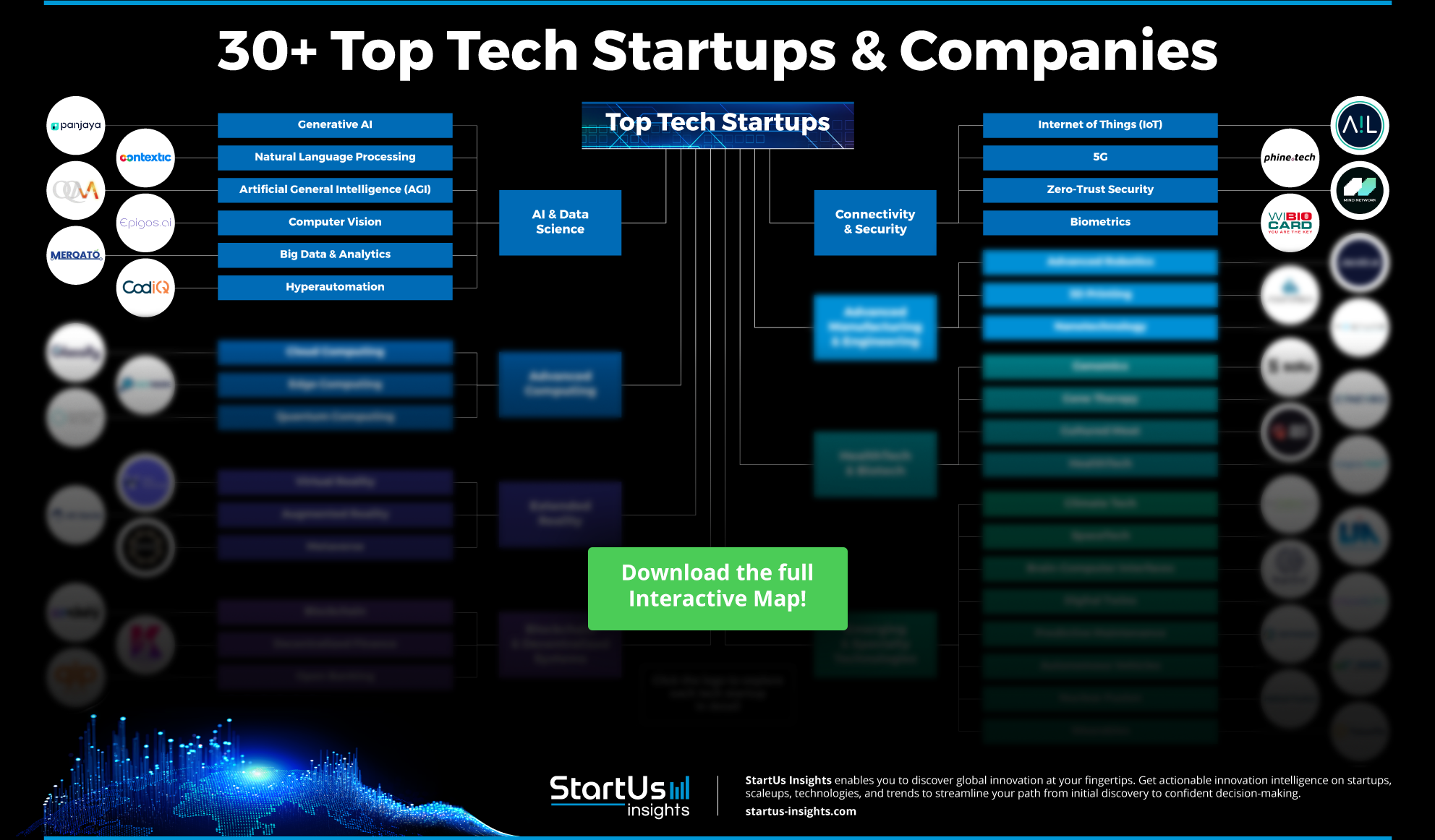
6. CleanTech

3 Practical Use Cases of CleanTech in Energy
- Energy Storage Solutions: Scalable storage technologies, like advanced batteries and thermal storage systems, stabilize energy supply by storing excess power generated from renewable sources. Also, it integrates renewables into the grid to reduce dependency on fossil fuels and enhance grid resilience.
- Smart Grids: The integration of real-time data analytics and automated control systems optimizes energy distribution and reduces waste. This improves efficiency by balancing supply and demand, minimizing outages, and supporting the adoption of decentralized energy resources like solar and wind.
- Energy Efficiency Improvements: Innovative materials, technologies, and processes reduce energy consumption in buildings, industrial processes, and transportation to reduce operational costs and carbon emissions.
Startup to Watch: Realta Fusion
US-based startup Realta Fusion makes a compact fusion system for decarbonizing industrial heat and power. It utilizes a magnetic mirror concept, where two high-field superconducting magnets confine a plasma causing charged particles to bounce back and forth in a mirror effect. This improves plasma confinement and enables heating through ion and electron radio-frequency (RF) heating combined with high-energy neutral particle injection. The modular, prefabricated fusion systems undergo customization to provide zero-carbon energy production with no greenhouse gas emissions.
7. Cloud Computing

Cloud computing leverages the latest technologies like edge computing for faster data processing close to energy assets. Also, it uses hybrid cloud systems that integrate both public and private cloud infrastructures. Further, AI and machine learning forecast energy demands and optimize energy loads, while blockchain ensures secure and transparent data transactions. Similarly, quantum computing explores advanced energy modeling and simulation for precise energy demand predictions. These advancement enhance digital integration and operational control.
3 Practical Use Cases of Cloud Computing in Energy
- Distributed Energy Resources (DER) Management: Cloud computing provides a centralized platform to process data from DERs to enable real-time decision-making and optimization. This increases the efficiency of renewables integration, balances supply and demand, and reduces reliance on traditional energy sources.
- Grid Analytics: Cloud-based solutions analyze datasets from various grid components for predictive analytics and proactive maintenance. It prevents outages, optimizes grid performance, and reduces operational costs by identifying potential issues before they escalate.
- Remote Asset Monitoring: Real-time tracking and management of energy infrastructure across geographically dispersed locations improves the reliability and longevity of assets. This provides timely interventions and reduced downtime.
Startup to Watch: Pratexo
Pratexo is a US-based startup that offers a power-balancing solution framework to manage real-time energy supply and demand fluctuations in electrification ecosystems. The framework integrates distributed energy sources and provides rapid response times to frequency deviations for power brokering. Further, it allows for real-time system control by interfacing with fast frequency reserve (FFR) and frequency containment reserve (FCR) services. Moreover, the company maintains grid stability with its customizable solutions hosted on an edge-to-cloud platform.
8. Connectivity Technologies

The energy industry advances with connectivity technologies tailored for grid management, renewable integration, and remote operations. For example, low earth orbit (LEO) satellites provide real-time, global data coverage, for monitoring distributed energy assets. 5G non-terrestrial networks (NTN) ensure ultra-low latency communications for grid stability and real-time energy distribution. Also, quantum encryption secures sensitive energy data, while optical laser communications enable long-range, high-speed data transfer. IoT sensors integrated with edge computing enhance localized energy control and predictive maintenance. These technologies improve the digital infrastructure of energy systems globally.
3 Practical Use Cases of Connectivity Technologies in Energy
- Smart Meters: Connectivity technologies enable real-time data transmission between consumers and utilities with smart meters. This provides real-time visibility to monitor energy consumption and reduce energy waste.
- Demand Response: Energy providers and consumers communicate with connectivity technologies for automated adjustment of energy usage during peak times. It balances the load on the grid, prevents outages, and reduces expensive and polluting peaker plants.
- Grid Automation: The integration of sensors, control systems, and data analytics automates grid operations management. It improves the grid’s efficiency by optimizing energy distribution, reducing downtime, and enabling faster response to faults.
Startup to Watch: DEWINE Labs
Austrian startup DEWINE Labs provides Bluetooth low energy (BLE) communication solutions for wireless data exchange. These solutions utilize optimization algorithms to ensure real-time data transmission over long distances. Further, they adjust communication parameters to maintain reliability, provide interoperability across different wireless technologies, and extend battery life through energy-efficient operations. Also, the company enhances BLE devices with increased range, higher throughput, and real-time capabilities for improved connectivity and productivity.
9. Internet of Things (IoT)

The connectivity with IoT enhances operational efficiency with real-time monitoring and resource optimization. It connects a network of sensors, devices, and data analytics platforms across energy grids, oil fields, and renewable energy installations. This improves decision-making and predictive maintenance. Moreover, the connectivity allows for precise control over energy generation and distribution to reduce waste and improve energy supply reliability. With 5G networks, IoT applications in the energy sector offer faster data processing and manage complex energy systems more effectively.
3 Practical Use Cases of IoT in Energy
- Asset Management: IoT connects physical assets to centralized monitoring systems for real-time tracking of their performance and health. It assists in the efficient use of resources, reduces operational costs, and ensures better decision-making by providing detailed insights into asset utilization and life cycle.
- Predictive Maintenance: The deployment of sensors across equipment monitors their condition. Also, it provides early detection of potential issues before they lead to failures. This reduces unplanned downtime, extends the lifespan of critical infrastructure, and lowers maintenance costs.
- Smart Transformers: Monitoring and controlling the transformer performance in real-time adjusts operations to meet varying load demands and environmental conditions. Such smart management improves energy efficiency, reduces losses, and enhances the overall stability of the grid.
Startup to Watch: EcoPhi Renewables Engineering
German startup EcoPhi Renewables Engineering develops an advanced photovoltaic (PV) and energy management platform to optimize renewable energy systems. It monitors, controls, and enhances the performance of solar installations, energy storage systems, electric vehicle charging stations, and heat pumps. Further, it provides real-time data analysis, customizable alerts, and reports to manage energy consumption, reduce operating costs, and increase energy efficiency.
10. Advanced Robotics

The integration of robotics in energy sectors, particularly in inspection and maintenance, enhances precision and safety while reducing operational costs. Advanced robots with AI and machine learning perform complex tasks in hazardous environments. For example, they minimize human exposure to risks in places such as offshore oil rigs and nuclear power plants. These robots also provide real-time data collection and analysis for improving decision-making and operational efficiency.
3 Practical Use Cases of Robotics in Energy
- Inspection of Energy Infrastructure: Autonomous drones and crawlers navigate complex environments. They conduct detailed inspections and capture high-resolution images and sensor data without risking human lives. It enhances safety, reduces inspection times, and lowers costs to keep infrastructure like wind turbines and offshore rigs in optimal condition.
- Automated Repair: Robots employ precision tools and AI-driven systems to conduct repairs in hazardous or hard-to-reach areas, such as underwater pipelines or high-voltage power lines. Such automation minimizes human intervention in dangerous environments and increases the efficiency and accuracy of repairs.
- Pipeline Monitoring: Integration of robotics with advanced sensors monitors leaks, corrosion, and other potential failures. By providing real-time data and conducting immediate interventions, this technology reduces environmental disaster risks and ensures the safe and efficient transport of energy resources.
Startup to Watch: Solar Bot
Based out of Brazil, Solar Bot is a startup that provides an autonomous solution for solar panel cleaning through its advanced, waterless robotic technology. The company offers two models, S-Bot and S1. The models use wind flow to gently remove dirt without friction for cleaning without water. This maximizes energy generation efficiency and reduces operating expenses.
Outlook for the Energy Industry
Patents & Grants
The sector has filed over 43 000 patents that demonstrate intense R&D efforts and a focus on securing intellectual property.
For more actionable insights, download our free Energy Innovation Report.
Investment Landscape
The average investment value for energy startups stands at USD 13.5 million per round. The top five investors include Techstars, CleanTech Open, Y Combinator, Congruent Ventures, and EIT Innoenergy. Moreover, the top 5 funding types are SEED, Early Stage VC/Series A, Pre Seed, Venture Round, and Debt Financing.
Global Footprint
The industry employs 8.2 million individuals globally, with significant representation in the USA, UK, India, Germany, and Canada.
Leverage Emerging Energy Technologies
Ready to leverage the latest energy technologies shaping the future? With StartUs Insights, you gain quick and easy access to over 4.7 million startups, scaleups, and tech companies, along with 20,000 emerging technologies and trends. Our AI-powered search and real-time database provide exclusive solutions that set you apart from the competition.
Industry giants like Samsung, Nestlé, and Magna trust our innovation intelligence tools to lead trends, optimize operations, and uncover new market opportunities. For example, Oscar Cantalejo, the startup program manager at Iberdrola, says “Through collaborating with StartUs Insights, we discovered new startups for pilot projects and are able to find & test new ideas that help us to improve and generate new business opportunities.”
Like them, you can benefit from our unmatched data, comprehensive industry views, and reliable insights to drive strategic decision-making. Get in touch to learn how our tailored discovery options can accelerate your innovation journey.
Discover All Energy Technologies & Startups!


